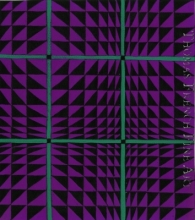

Thomas French Fine Art
Exhibition of French Master Prints and Drawings of the Late 19th and Early 20th Century
During the 1870s and 1880s, French art was revolutionized by a group of artists dubbed the Impressionists who introduced radical new techniques and compositions that opened the floodgates for creative experimentation with Paris at the center. Three charming Impressionist prints by Pierre August Renoir, Mary Cassatt, and Edgar Degas are featured in this exhibition. Renoir’s affectionate portrayal of his third son in Claude Renoir, la Tête Baisée in particular demonstrates the artist’s sensitive attention to intimate and candid compositions.
The 1890s were characterized by the creative period of the Belle Époque that continued until the beginning of World War I in 1914. Encouraged by peace and prosperity in Paris, Post-Impressionist artists including Henri de Toulousse-Lautrec, Louis Legrand, Felix-Edouard Vallotton, Théophile-Alexandre Steinlen strove to capture the golden age of Parisian social life. À la Renaissance: Sarah Bernhardt dans Phedre by Toulousse-Lautrec depicts the first star of the French stage, Sarah Bernhardt, as Phaedra in Jean Racine’s dramatic tragedy about a woman in love with her stepson. During this time the influence of Japanese printmaking was also particularly strong demonstrated here by two of Paul Berthon’s Art Nouveau prints and Henri Riviere Japonisme print of a washhouse in Tréboul, Brittany.
The turn of the century in France continued to be dominated by experiments with the new color and content of Impressionism and Post-Impressionism. This period was marked by the emergence of Nabis artists Edouard Vuillard, Pierre Bonnard, and Ker-Xavier Roussel. These three artists, who were all friends, adopted an artistic style, which included a rejection of traditional methods and the introduction of flat shapes non-naturalistic color, and dark contours similar to the graphic approach of a Japanese print. Ultimately, however, these artists were most concerned with returning art to its original function as decoration. Ker-Xavier Roussel in particular was most well known for his French landscape depictions of women, children, nymphs and fauns in pastoral settings, evidenced in Neo-Classical Scene.
Picasso considered himself the greatest artist working in Paris from his arrival in 1900 to his death in 1973. One of his rivals for public acclaim was Georges Rouault. Both artists used original graphics as a significant focus of their creativity. The Picasso etching Les Pauvres depicts a family of circus performers and is part of the artist’s highly regarded “Blue Period.” The two Rouault works show a compositional use of black lines to outline the composition inspired by the magnificent Gothic stained glass found in and around Paris. This distinctive style is easily discernable once you view his work.
There are works in this exhibition for the starting as well as the advanced collectors and museums with prices range from $300 upward.
Please let us know if you have any questions regarding these works of art or other works on the website.
Keep in mind that we have multiples examples of artwork by many of the artists featured in this exhibition that one can view by using our artist search function.
Finally, we are also currently building our email address book. If you wish to receive our e-blasts announcing new exhibitions on our website, please provide us you contact information via email.
En passant (Passing by)
By
Louis Legrand
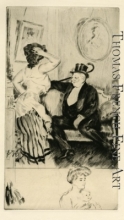
Neo-Classical Scene
By
Ker-Xavier Roussel
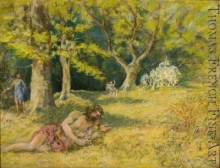
Le Matin (Morning)
By
James Jacques Tissot
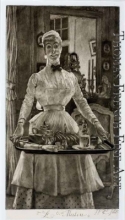
Berthe
By
James Jacques Tissot
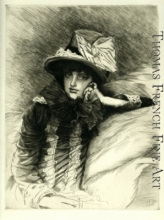
Fabric Design
By
Lizzie Derriey Design Studio
